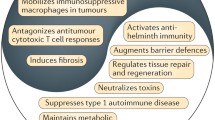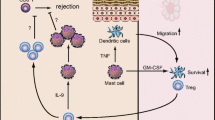Summary
Cellular immune reactions play a major role in autoimmunity, as autoreactive T lymphocytes appear to recognize autoantigens and major histocompatibility complex (MHC) class II restriction molecules presented by aberrant nonimmune cells, leading to damage to healthy tissues. Evidence has accumulated to suggest that histamine participates in the regulation of the immune response via binding to specific histamine receptors expressed on cells of immune origin. Histamine may be involved in the development of autoimmune disease via a pathological change in its regulation of the expression of MHC class II restriction antigens by action on histamine H2 receptors.
Well-established treatment modalities such as cyclosporin and methotrexate have recently been shown to inhibit histamine release, and this may therefore support the action of histamine in the pathophysiology of autoimmunity. As selective immunotherapy may be of value in the treatment of some autoimmune diseases, the use of mast cell stabilising drugs or specific histamine H2 receptor antagonists should be evaluated in patients where conventional therapy has failed to reduce disease activity.
Similar content being viewed by others
References
Adorini L, Guéry JC, Trembleu S, et al. Selective immunosuppression. Immunol Today 1993; 14: 285–9
Ferraro AS, Newkirk MM. Correlative studies of rheumatoid factors and anti-viral antibodies in patients with rheumatoid arthritis. Clin Exp Immunol 1993; 92: 425–31
Staszak C, Goodwin JS, Troup GM, et al. Decreased sensitivity to prostaglandin and histamine in lymphocytes from normal HLA-B12 individuals: a possible role in autoimmunity. J Immunol 1980; 125: 181–5
Gordon JR, Burd PR, Galli SJ. Mast cells as a source of multifunctional cytokines. Immunol Today 1990; 11: 458–64
Nielsen HJ. Histamine and histamine type 2 receptor antagonists in psoriasis. Mechanisms and speculations. Dan Med Bull 1991; 38: 478–80
Nielsen HJ, Hammer JH. Possible role of histamine in pathogenesis of autoimmune diseases: implications for immunotherapy with histamine-2 receptor antagonists. Med Hypotheses 1992; 39: 349–55
Fox CC, Lichtenstein LM, Roche JK. Intestinal mast cell responses in idiopathic inflammatory bowel disease: histamine release from human intestinal mast cells in response to gut epithelial proteins. Digest Dis Sci 1993; 38: 1105–12
Auger MJ. Mononuclear phagocytes. Br Med J 1989; 298: 546–8
Unanue ER, Allen PM. The basis for the immunoregulatory role of macrophages and other accessory cells. Science 1987; 236: 551–7
Berzofsky JA, Brett SJ, Streicher HZ, et al. Antigen processing for the presentation to T lymphocytes: function, mechanisms, and implications for the T-cell repertoire. Immunol Rev 1988; 106: 5–31
Royer HD, Reinherz EL. T-lymphocyte: ontogeny, function and relevance to clinical disorders. N Engl J Med 1987; 317: 1136–42
Gupta S. Mechanisms of transmembrane signalling in human T cell activation. Mol Cell Biochem 1989; 91: 45–50
Dinarello CA. Biology of interleukin-1. FASEB J 1988; 2: 108–15
Murray HW. Interferon-gamma, the activated macrophage, and the host defense against microbial challenge. Ann Intern Med 1988; 108: 595–608
Debets JM, van der Linden CJ, Spronken IE, et al. T cell-mediated production of tumor necrosis factor-alpha by monocytes. Scand J Immunol 1988; 27: 601–8
Castell JV, Andus T, Kunz D, et al. Interleukin-6. The major regulator of acute-phase protein synthesis in man and rat. Ann NY Acad Sci 1989; 557: 87–99
Phipps RP, Stein SH, Roper RL. A new view of prostaglandin E regulation of immune response. Immunol Today 1991; 12: 349–51
Lopez AF, Elliott MJ, Woodcock J, et al. GM-CSF, IL-3 and IL-5: crosscompetition on human haematopoitic cells. Immunol Today 1992; 13: 495–500
Smith KA. Lowest dose interleukin-2 immunotherapy. Blood 1993; 81: 1414–23
Arnon R, Teitelbaum D. On the existence of suppressor cells. Int Arch Allergy Immunol 1993; 100: 2–7
von Boehmer H, Kisielow P. How the immune system learns about self. Sci Am 1991; 286: 50–9
Janeway CA. The immune system evolved to discriminate infectious nonself from noninfectious self. Immunol Today 1992; 13: 11–6
Kroemer G, Martinez C. The fail-safe paradigm of immunological self-tolerance. Lancet 1991; 338: 1246–9
Cohen IR. The self, the world, and autoimmunity. Sci Am 1988; 258: 34–42
Parker DC, Eynon EE. Antigen presentation in aquired immunological tolerance. FASEB J 1991; 5: 2777–84
Goss JA, Nakafusa Y, Flye MW. MHC class II presenting cells are necessary for the induction of intrathymic tolerance. Ann Surg 1993; 217: 492–501
Kappler JW, Roehm N, Marrack P. T-cell tolerance by clonal elimination in the thymus. Cell 1987; 49: 273–80
Jenkins MK. The role of cell division in the induction of clonal anergy. Immunol Today 1992; 13: 69–73
Miller A, Hafler DA, Weiner HL. Tolerance and suppressor mechanisms in experimental autoimmune encephalomyelitis: implications for immunotherapy of human autoimmune diseases. FASEB J 1991; 5: 2560–6
Baadsgaard O, Gupta AK, Taylor RN, et al. Psoriatic epidermal cells demonstrate increased numbers and function of non-Langerhans antigen-presenting cells. J Invest Dermatol 1989; 92: 190–5
Wucherpfenning KW, Weiner HL, Hafler DA. T-cell recognition of myelin basic protein. Immunol Today 1991; 12: 277–82
Thrane PS, Haistensen TS, Haanaes HR, et al. Increased epithelial expression of HLA-DQ and HLA-DP molecules in salivary glands from patients with Sjögren’s syndrome compared with obstructive sialadenitis. Clin Exp Immunol 1993; 92: 256–62
Dimal P. Truschnig MW, Mooij P, et al. Expression of various MHC class II molecules and of intracellular adhesion molecules-1 (ICAM-1) on focal clusters of dendritic cells in iodine deficiency goitres. Clin Exp Immunol 1993; 92: 397–403
Okazaki K, Morita M, Nishimori I, et al. Major histocompatibility antigen-restricted cytotoxicity in inflammatory bowel disease. Gastroenterology 1993; 104: 384–91
Toyoda H, Wang SJ, Yang HY, et al. Distinct associations of HLA class II genes with inflammatory bowel disease. Gastroenterology 1993; 104: 741–8
Broomé U, Hultcrantz R, Scheynius A. Lack of concominant expression of ICAM-1 and HLA-DR on bile duct from patients with primary sclerosing cholangitis and primary biliary cirrhosis. Scand J Gastroenterol 1993; 28: 126–30
Williams JG, Jurkovich GJ, Maier RV. Interferon-γ: a key immunoregulatory lymphokine. J Surg Res 1993; 54: 79–93
Barker JN, Navsaria HA, Leigh IM, et al. Gamma-interferon induced human keratinocyte HLA-DR synthesis: the role of dermal activated T lymphocytes. Br J Dermatol 1988; 119: 567–72
Lieberman BY, Fiocchi C, Youngman KR, et al. Interferon gamma production by human intestinal mucosal mononuclear cell. Decreased levels in inflammatory bowel disease. Digest Dis Sci 1988; 33: 1297–304
Yeatman N, Sachs J, Bottazzo GF. Autoimmunity — towards the year 2001. Immunol Today 1992; 13: 239–40
Hibi T, Ohara M, Watanabe M, et al. Interleukin 2 and interferon gamma augment anticolon antibody dependent cellular cytotoxicity in ulcerative colitis. Gut 1993; 34: 788–93
Panich HS, Hirsh RL, Schindler J, et al. Treatment of multiple sclerosis with gamma interferon: exacerbations associated with activation of the immune system. Neurology 1987; 37: 1097–102
Klinman DM. IgG1 and IgG2a production by autoimmune B cells treated in vitro with IL-4 and IFN-γ. J Immunol 1990; 144: 2529–34
Grant JA, Alam R, Lett-Brown MA. Histamine-releasing factors and inhibitors: historical perspectives and possible implications in human illness. J Allergy Clin Immunol 1991; 88: 683–93
Pearce FL. Biological effects of histamine: an overview. Agents Actions 1991; 33: 4–7
Farber EM, Nickoloff BJ, Recht B, et al. Stress, symmetry and psoriasis: possible role of neuropeptides. J Am Acad Dermatol 1986; 14: 305–11
Falus A, Merétey K. Histamine: an early messenger in inflammatory and immune reactions. Immunol Today 1992; 13: 154–6
Neugebauer E, Lorenz W, Beckurts T, et al. Significance of histamine formation and release in the development of endotoxic shock. Rev Infect Dis 1987; 9: 585–93
Sitter H, Lorenz W, Klotter HJ, et al. Elevated plasma histamine concentration as a sensitive real-time parameter for distinct phases of surgical trauma: a tool for technology assessment. Agents Actions 1991; 33: 203–7
Nielsen HJ. Histamine in neoplastic diseases. In: Skov PS, editor. Histamine in health and disease. Copenhagen: Munksgaard, 1994. In press
Nielsen HJ, Kikuchi Y. Histamine-2 receptor antagonists as potential adjuvant treatment of malignant diseases. In: Garcia-Caballero M, Brandes LB, Hosoda S, editors. Histamine in normal and cancer cell proliferation. London: Pergamon Press, 1993: 319–334
Beer DJ, Rocklin RE. Histamine modulation of lymphocyte biology: membrane receptors, signal transduction, and functions. CRC Crit Rev Immunol 1987; 7: 55–91
Parsons ME. Histamine receptors: an overview. Scand J Gastroenterol 1991; 26: 46–52
Carlsson R, Dohlsten M, Sjögren HO. Histamine modulates production of interferon-gamma and interleukin-2 by mitogen-activated human mononuclear blood cells. Cell Immunol 1985; 96: 104–12
Sansoni P, Silverman ED, Khan MM, et al. Immuno-regulatory T cells in man: histamine-induced suppressor cells are derived from a Leu 2+ (T8+) subpopulation distinct from that which gives rise to cytotoxic T cells. J Clin Invest 1985; 75: 650–5
Khan MM, Keaney KM, Melmon KL, et al. Histamine regulates the generation of human cytolytic T lymphocytes. Cell Immunol 1989; 121: 60–73
Galli SJ. New concepts about the mast cell. N Engl J Med 1993; 328: 257–65
Brody I. Mast cell degranulation in the evolution of acute eruptive guttate psoriasis vulgaris. J Invest Dermatol 1984; 82: 460–5
Nolte H, Spjeldnaes N, Kruse A, et al. Histamine release from gut mast cells from patients with inflammatory bowel disease. Gut 1990; 31: 791–4
Clementsen P, Jensen CB, Jarløv JO, et al. Virus enhances histamine release from human basophils. Agents Actions 1988; 23: 165–7
Schmidt WU, Sattler J, Lorenz W, et al. Human intestinal diamine oxidase (DAO) activity in Crohn’s disease: a new marker for disease assessment? Agents Actions 1990; 30: 267–70
Maudsley DJ, Pound JD. Modulation of MHC antigen expression by viruses and oncogenes. Immunol Today 1991; 12: 429–31
Niederwasser D, Auböck J, Troppmair J, et al. IFN-mediated induction of MHC antigen expression on human keratinocytes and its influence on in vitro alloimmune response. J Immunol 1988; 140: 2556–62
Dohlsten M, Sjögren HO, Carlsson R. Histamine inhibits interferon-gamma production via suppression of interleukin-2 synthesis. Cell Immunol 1986; 101: 493–501
Antel JP, Bania MB, Reder A, et al. Activated suppressor cell dysfunction in progressive multiple sclerosis. J Immunol 1986; 137: 137–44
Baxevanis CN, Reclos GJ, Papamichail M. Decreased HLA-DR antigen expression on monocytes causes impaired suppressor cell activity in multiple sclerosis. J Immunol 1990; 144: 4166–71
Pedersen C, Permin H, Skov PS, et al. Inhibitory effect of cyclosporine A on histamine release from human leukocytes and rat mast cells. Allergy 1985; 40: 103–7
Nolte H, Skov PS. Inhibition of basophil histamine release by methotrexate. Agents Actions 1988; 23: 173–6
Triggiani M, Cirillo R, Lichtenstein LM, et al. Inhibition of histamine and prostaglandin D2 release from human mast cells by cyclosporin A. Int Arch Allergy Appl Immunol 1989; 88: 253–5
Crotty B, Hoang P, Dalton HR, et al. Salicylates used in inflammatory bowel disease and colchicine impair interferon-γ induced HLA-DR expression. Gut 1992; 33: 59–64
Isaacs JD, Watts RA, Hazleman BL, et al. Humanised monoclonal antibody therapy for rheumatoid arthritis. Lancet 1992; 340: 748–52
Waldmann H, Cobbold S. The use of monoclonal antibodies to achieve immunological tolerance. Immunol Today 1993; 14: 247–51
Rask-Madsen J, Bukhave K, Laursen LS, et al. 5-Lipooxygenase inhibitors for the treatment of inflammatory bowel disease. Agents Actions 1992; Conference Issue: C37–C46
van Zyl JM, Kriegler A, van der Walt BJ. Anti-oxidant properties of H-2 receptor antagonists. Biochem Pharmacol 1993; 45: 2389–97
Eliakim R, Karmeli F, Racmilewitz D. Ketotifen — old drug, new indication: reduction of gastric micosal injury. Scand J Gastroenterol 1993; 28: 202–4
Pothoulakis C, Karmeli F, Kelly CP, et al. Ketotifen inhibits Clostridium difficile toxin A-induced enteritis in rat ileum. Gastroenterology 1993; 105: 701–7
Nielsen HJ, Nielsen H, Georgsen J. Ranitidine for improvement in treatment-resistent psoriasis. Arch Dermatol 1991; 127: 270
Witkamp L, Velthuis PJ, Verhaegh ME, et al. An open prospective clinical trial with systemic ranitidine in the treatment of psoriasis. J Am Acad Dermatol 1993; 28: 778–81
Nielsen HJ, Nielsen H, Jensen S, et al. Ranitidine improves postoperative monocyte and neutrophil function. Arch Surg 1994. In press
Author information
Authors and Affiliations
Rights and permissions
About this article
Cite this article
Nielsen, H.J. Role of Histamine in the Pathogenesis of Autoimmune Disease. Clin. Immunother. 1, 250–257 (1994). https://doi.org/10.1007/BF03259251
Published:
Issue Date:
DOI: https://doi.org/10.1007/BF03259251




